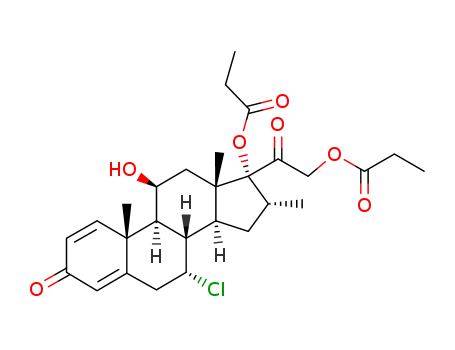- Chemical Name:Alclometasone
- CAS No.:66734-13-2
- Molecular Formula:C28H37ClO7
- Molecular Weight:521.051
- Hs Code.:2937220000
- UNII:136H45TB7B
- DSSTox Substance ID:DTXSID60867277
- Nikkaji Number:J18.598A
- Wikipedia:Alclometasone
- Wikidata:Q4713192
- NCI Thesaurus Code:C65219
- RXCUI:108088
- Metabolomics Workbench ID:42642
- ChEMBL ID:CHEMBL1201361
- Mol file:66734-13-2.mol
Synonyms:alclometasone;67452-97-5;Aclometasone;Alclometasone [INN:BAN];7alpha-Chloro-16alpha-methylprednisolone;UNII-136H45TB7B;Alclometasone (INN);136H45TB7B;(7R,8S,9S,10R,11S,13S,14S,16R,17R)-7-chloro-11,17-dihydroxy-17-(2-hydroxyacetyl)-10,13,16-trimethyl-7,8,9,11,12,14,15,16-octahydro-6H-cyclopenta[a]phenanthren-3-one;CHEBI:53776;ALCLOMETASONE [INN];(7alpha,11beta,16alpha)-7-chloro-11,17,21-trihydroxy-16-methylpregna-1,4-diene-3,20-dione;ALCLOMETASONE [MI];D0F1EX;SCHEMBL4127;ALCLOMETASONE [VANDF];ALCLOMETASONE [WHO-DD];CHEMBL1201361;7a-hloro-16a-ethyl prednisolone;DTXSID60867277;HY-A0150;AKOS040741062;DB00240;7-alpha-chloro-16-alpha-methylprednisolone;CS-0017475;D07116;EN300-25042268;Q4713192;(1R,2R,3aS,3bS,4R,9aR,9bS,10S,11aS)-4-chloro-1,10-dihydroxy-1-(2-hydroxyacetyl)-2,9a,11a-trimethyl-1H,2H,3H,3aH,3bH,4H,5H,7H,9aH,9bH,10H,11H,11aH-cyclopenta[a]phenanthren-7-one;(1S,2R,9R,10S,11S,13R,14R,15S,17S)-9-chloro-14,17-dihydroxy-14-(2-hydroxyacetyl)-2,13,15-trimethyltetracyclo[8.7.0.0^{2,7}.0^{11,15}]heptadeca-3,6-dien-5-one;(7-alpha,11-beta,16-alpha)-7-Chloro-11,17,21-trihydroxy-16-methylpregna-1,4-diene-3,20-dione;(7.ALPHA.,11.BETA.,16.ALPHA.)-7-CHLORO-11,17,21-TRIHYDROXY-16-METHYLPREGNA-1,4-DIENE-3,20-DIONE;(7a,11b,16a)-7-Chloro-11-hydroxy-16-methyl-17,21-bis(1-oxopropoxy)pregna-1,4-diene-3,20-dione;PREGNA-1,4-DIENE-3,20-DIONE, 7-CHLORO-11,17,21-TRIHYDROXY-16-METHYL-, (7.ALPHA.,11.BETA.,16.ALPHA.)-




